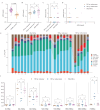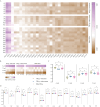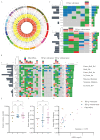Cell-free DNA profiles of dermatomyositis and its potential role in discriminating phenotypes
- PMID: 40599779
- PMCID: PMC12209249
- DOI: 10.3389/fimmu.2025.1605121
Cell-free DNA profiles of dermatomyositis and its potential role in discriminating phenotypes
Abstract
Background: Cell-free DNA (cfDNA) functions in the early-detection and monitoring of autoimmune diseases including systemic lupus erythematosus and rheumatoid arthritis. However, investigations into cfDNA profiles in dermatomyositis and their potential clinical implications remain scarce.
Objectives: To explore the overall landscape of cfDNA profiles in dermatomyositis and investigate potential roles in discriminating subtypes.
Methods: Following informed consent, 24 treatment-naïve patients diagnosed with dermatomyositis and 16 healthy controls were enrolled. We examined cfDNA concentrations, fragment distribution patterns, 5'-end motif frequencies and genetic variation profiles in all participants and studied potential correlation with laboratory parameters. Moreover, intergroup differences of cfDNA profiles among patients and potential correlation between extracellular DNases levels and cfDNA were investigated.
Results: Compared to healthy controls, dermatomyositis patients exhibited elevated cfDNA concentrations, with significantly longer cfDNA fragments, primarily centered around 180-360 bp; nonetheless, no correlation was witnessed between lab parameters and cfDNA levels. The A-end predominated the 5'-end motif, whereas the C-end was underrepresented, contrasting with the patterns observed in healthy controls. In addition, genetic variations in several genes, including PDE4DIP and BRCA2, were commonly detected in cfDNA from dermatomyositis patients. Notably, end-motif profiles and cfDNA fragment length exhibited variations between anti-transcription intermediary factor 1-gamma positive patients with and without malignancies. However, owing to limited sample size, we failed to draw conclusions regarding extracellular DNase levels.
Conclusions: This study presents the first comprehensive depiction of cfDNA profiles in patients with dermatomyositis. Furthermore, cfDNA features exhibit variability across some sub-phenotypes and may serve as discriminatory indices. Finally, potential involvement of extracellular DNases in cfDNA profiles in dermatomyositis shall be further investigated.
Keywords: 5’ end-motif; cell-free DNA; dermatomyositis; fragmentation; genetic variance.
Copyright © 2025 Tang, Chen, Zhang, Cao, Dai, Lou, Sun, Zhou, Chen, Zhang, Wang and Man.
Conflict of interest statement
The authors declare that the research was conducted in the absence of any commercial or financial relationships that could be construed as a potential conflict of interest.
Figures




Similar articles
-
Systemic pharmacological treatments for chronic plaque psoriasis: a network meta-analysis.Cochrane Database Syst Rev. 2017 Dec 22;12(12):CD011535. doi: 10.1002/14651858.CD011535.pub2. Cochrane Database Syst Rev. 2017. Update in: Cochrane Database Syst Rev. 2020 Jan 9;1:CD011535. doi: 10.1002/14651858.CD011535.pub3. PMID: 29271481 Free PMC article. Updated.
-
Systemic pharmacological treatments for chronic plaque psoriasis: a network meta-analysis.Cochrane Database Syst Rev. 2021 Apr 19;4(4):CD011535. doi: 10.1002/14651858.CD011535.pub4. Cochrane Database Syst Rev. 2021. Update in: Cochrane Database Syst Rev. 2022 May 23;5:CD011535. doi: 10.1002/14651858.CD011535.pub5. PMID: 33871055 Free PMC article. Updated.
-
Sex-related differences in cell-free DNA and neutrophil extracellular traps in patients with hematologic malignancies.Immunol Res. 2025 Aug 26;73(1):124. doi: 10.1007/s12026-025-09677-8. Immunol Res. 2025. PMID: 40856921 Free PMC article.
-
Topotecan, pegylated liposomal doxorubicin hydrochloride and paclitaxel for second-line or subsequent treatment of advanced ovarian cancer: a systematic review and economic evaluation.Health Technol Assess. 2006 Mar;10(9):1-132. iii-iv. doi: 10.3310/hta10090. Health Technol Assess. 2006. PMID: 16545208
-
Cell-free epigenomes enhanced fragmentomics-based model for early detection of lung cancer.Clin Transl Med. 2025 Feb;15(2):e70225. doi: 10.1002/ctm2.70225. Clin Transl Med. 2025. PMID: 39909829 Free PMC article.
References
MeSH terms
Substances
LinkOut - more resources
Full Text Sources
Miscellaneous

